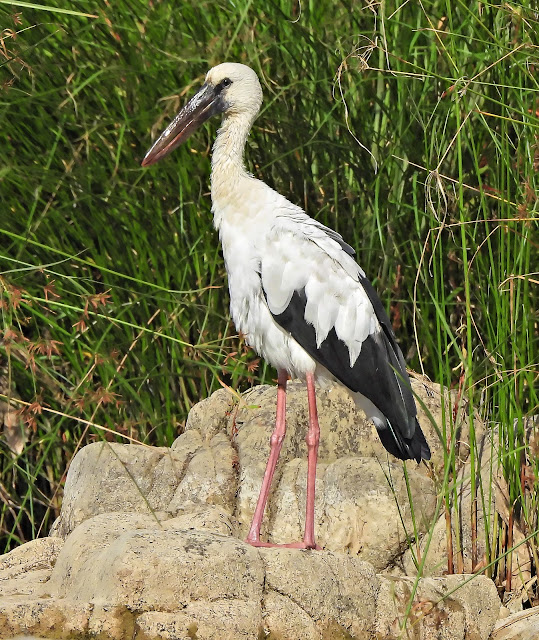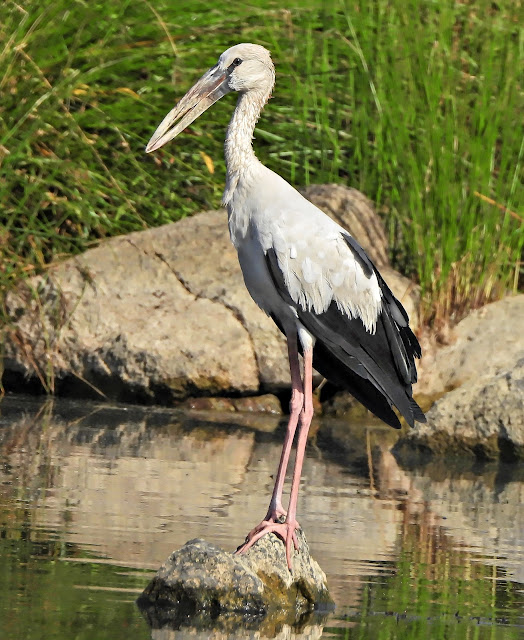The Red-wattled lapwing (Vanellus indicus) is large wader native to Asia. Like other lapwings, they are ground birds that are incapable of perching. This bird has many local names such as titahri (Hindi), titawi (Marathi), tittibha (Kannada), tateehar (Sindhi), titodi (Gujarati), hatatut (Kashmiri), balighora (Assamese), yennappa chitawa (Telugu), aal-kaati (Tamil, meaning "human indicator").
Red-wattled lapwings are large birds. Their wings and back are light brown with a purple to green sheen, but the head, a bib on the front, and the back of the neck are black. Prominently white patch runs between these two colors, from the belly and tail, flanking the neck to the sides of the crown. The short tail is tipped black. A red fleshy wattle in front of each eye, a black-tipped red bill, and long legs are yellow. In flight, prominent white wing bars formed by the white on the secondary coverts. Males and females are similar in plumage but males have a slightly longer wing and tend to have a longer carpal spur.

Red-wattled lapwings breed from West Asia (Iraq, SW Iran, Persian Gulf) eastwards across South Asia (Baluchistan, Sri Lanka, Afghanistan, Pakistan, the entire Indian subcontinent up to Kanyakumari and up to 1800m in Kashmir/Nepal), with another sub-species further east in Southeast Asia. These birds may migrate altitudinally in spring and autumn (e.g. in N. Baluchistan or NW Pakistan) and spread out widely in the monsoons on the creation of requisite habitats, but by and large, the populations are resident. Red-wattled lapwings inhabit almost any wetland habitat throughout their range including well-watered open country, flooded grasslands, marshes, rivers, pools, cultivated areas, ploughed fields, grazing land, and rural gardens.

Red-wattled lapwings are usually seen in pairs or trios not far from water. They occasionally form large flocks, ranging from 26 to 200 birds. They run about in short spurts and dip forward obliquely (with unflexed legs) to pick up food in a typical plover manner. They feed mainly during the day but are said to also feed at night being especially active around the full moon. They may sometimes make use of the legs to disturb insect prey from soft soil. Red-wattled lapwings are uncannily and ceaselessly vigilant, day or night, and are the first to detect intrusions and raise an alarm; their sounds have been variously rendered as ‘did he do it’ or ‘pity to do it’ leading to the colloquial name of ‘did-he-do-it bird’. Flight of Red-wattled lapwings is rather slow, with deliberate flaps, but the birds are capable of remarkable agility when defending their nest or being hunted by a hawk. They bathe in pools of water when available and will often spend time preening when leaving the nest. They sometimes rest on the ground with the tarsi laid flat on the ground and at other times may rest on one leg.

Red-wattled lapwings are monogamous and form pairs. They breed mainly from March to August. The courtship involves the male puffing its feathers and pointing its beak upwards. The male then shuffles around the female. Several males may display to females and they may be close together. The eggs are laid in a ground scrape or depression sometimes fringed with pebbles, goat or hare droppings. The female lays 3-4 black-blotched buff eggs shaped a bit like a peg-top (pyriform). Nests are difficult to find since the eggs are cryptically colored and usually match the ground pattern. In residential areas, they sometimes take to nesting on roof-tops. When nesting pairs are very territorial and will attempt to dive bomb or distract potential predators. Both parents incubate the eggs and divert predators using distraction displays or flash their wings to deter any herbivores that threaten the nest. Males relieve females incubating at the nest, particularly towards the hot part of noon. The eggs hatch in 28 to 30 days. When the chicks hatch they are cryptically patterned and immediately follow their parents to feed, hiding by lying low on the ground or in the grass when threatened. Parents often soak their belly feathers to provide water to their chicks as well as to cool the eggs during hot weather.












%2020.jpg)
%2020.jpg)



%2020.jpg)
%2022.jpg)
























%201.jpg)


